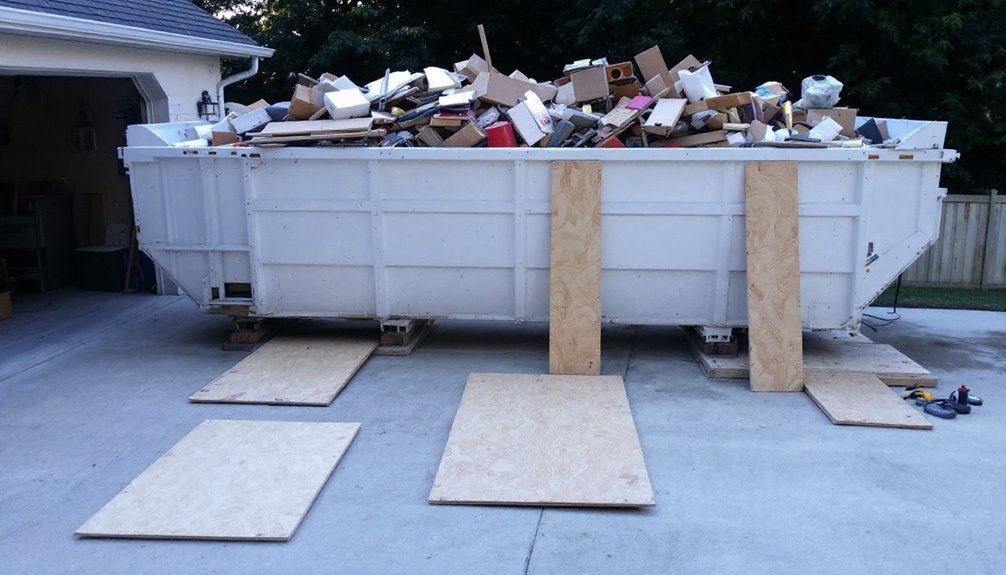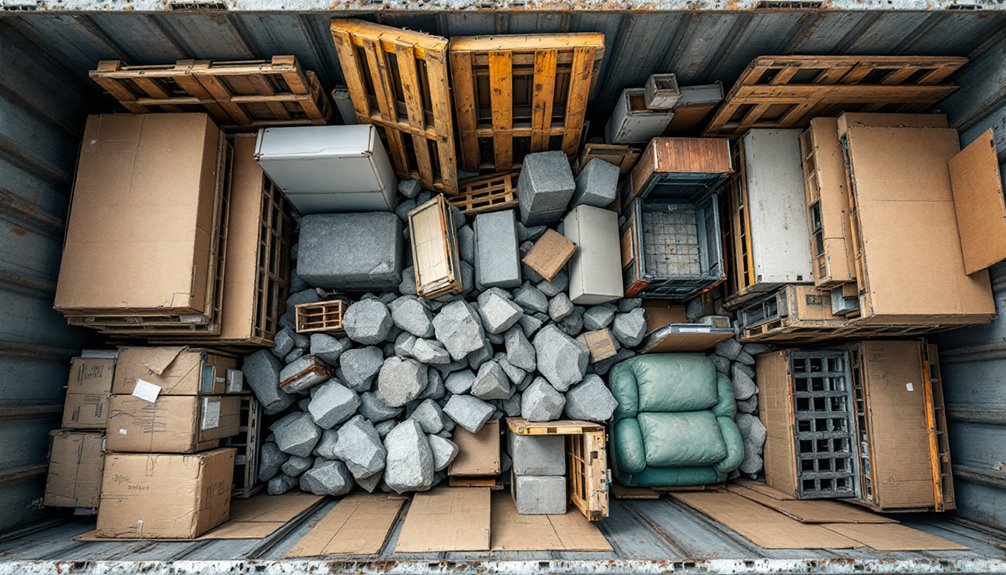Position your dumpster on a level surface with proper clearance and truck access. Start loading heavy items at the bottom, distributing weight evenly across the base. Break down bulky materials and fill gaps with smaller debris as you work from back to front. Don’t exceed the weight limit (typically 3.5-5 tons) and keep materials below the fill line. Follow these fundamentals, and you’ll discover advanced techniques to maximize your dumpster’s capacity.
Key Takeaways
- Place heaviest materials at the bottom and distribute them evenly to maintain stability and prevent shifting during transport.
- Start loading from the back of the dumpster and work your way forward, using the rear doors for easier access.
- Break down all bulky items like furniture and boxes to maximize space and ensure efficient use of dumpster capacity.
- Fill gaps between larger items with smaller debris to prevent wasted space and maintain balanced weight distribution.
- Monitor the fill line and keep materials level across the dumpster, never exceeding the marked capacity limit.
Strategic Placement and Location Guidelines

Setting up your 30-yard dumpster starts with choosing the right location. You’ll want to position it near your main work area on a stable surface – preferably concrete or asphalt, not grass or dirt. Remember to check for at least 60 feet of vertical clearance to avoid power lines and tree branches.
Your driveway needs to be at least 25 feet long and 10 feet wide to accommodate the standard dimensions of 22′ L x 8′ W x 6′ H. If you’re tight on space, consider street placement or a parking lot, but be sure to obtain the necessary permits first. Position your dumpster where roll-off trucks can easily access it for delivery and pickup. Implementing a systematic loading approach for optimal waste management helps maximize available space and ensures efficient disposal. Popular for extensive renovations, these dumpsters can handle up to 10,000 pounds of debris from residential and commercial projects.
Following these placement guidelines will help you maximize efficiency and comply with local regulations while keeping the process smooth for everyone involved.
Understanding Weight Distribution and Load Limits
You’ll need to stay within the 3.5 to 5-ton weight limit of your 30-yard dumpster while distributing heavy items evenly across the bottom. Spread materials from corner to corner rather than concentrating weight in one area to maintain stability and prevent shifting during transport.
Keep track of your load’s estimated weight as you fill the dumpster, especially when disposing of dense materials like roofing shingles or furniture.
Weight Capacity Basics
Understanding weight capacity is crucial before loading a 30-yard dumpster. Most providers set limits between 2-4 tons (4,000-8,000 pounds), though some allow up to 5 tons. You’ll want to stay within these limits to avoid additional fees and guarantee safe transportation.
- 150-180 standard 13-gallon trash bags
- 6,500 pounds of loose yard waste
- 4,200-6,000 square feet of carpeting
- 90-120 bundles of roofing shingles
Remember that certain materials like concrete, bricks, and dirt often aren’t accepted due to their weight. If you’re planning a project with heavy debris, consider renting a specialized heavy debris dumpster or splitting your load between two standard dumpsters.
Safe Loading Patterns
Proper loading patterns make all the difference when filling a 30-yard dumpster safely and efficiently. You’ll want to start by placing your heaviest items at the bottom and distributing them evenly across the floor to create a stable foundation. This approach helps prevent shifting during transport and maximizes your available space.
As you build upward, layer your materials strategically. Place medium-weight items in the middle section, and save your lightest materials for the top. Remember to stack vertically whenever possible, but don’t exceed the fill line marked on the dumpster’s sides. Breaking down bulky items like furniture and boxes will help you make the most of the space while maintaining a balanced load.
Always use the rear doors for easier access and safer loading.
Monitor Load Balance
Building on the foundation of safe loading patterns, monitoring your dumpster’s load balance is key to successful waste disposal. When loading your 30-yard dumpster, remember that proper weight distribution prevents safety hazards and guarantees smooth transport. You’ll want to stay within the 7,000 to 10,000-pound weight limit while maintaining even distribution.
Place the heaviest materials at the bottom to create a stable foundation. Distribute weight evenly from side to side to prevent tipping. Keep track of material weights – concrete and shingles are much heavier than household items. Monitor the fill line on all sides to ascertain balanced height.
Essential Safety Protocols and Regulations
Safety should be your top priority when loading a 30-yard dumpster. You’ll need to wear proper protective equipment, including gloves, sturdy shoes, and safety goggles to shield yourself from potential hazards. Make certain everyone on your team is properly trained in using this gear.
When it comes to lifting, don’t go it alone. Use proper techniques and ask for help with heavy items. You’ll find dollies and hand trucks incredibly useful for moving larger materials.
Keep the area around your dumpster clear of obstacles and guarantee the ground is stable. Remember to follow your local regulations and the rental company’s guidelines for weight limits and prohibited materials. Don’t exceed the dumpster’s capacity or dispose of hazardous items like paint, chemicals, or batteries.
Step-by-Step Loading Techniques
You’ll save significant space by breaking down large items like furniture and boxes before loading them into your 30-yard dumpster.
Start loading from the back of the dumpster and work your way toward the front, maintaining even distribution of weight throughout the container.
Fill any gaps between larger items with smaller debris to maximize the dumpster’s capacity and prevent load shifting during transport.
Breaking Down Large Items
Large items can take up valuable space in your 30-yard dumpster if not properly broken down first. You’ll want to maximize every cubic yard by following proven breakdown techniques that experienced contractors use. Start by disassembling furniture into its basic components and flattening any boxes or collapsible items.
When dealing with bulky materials, follow these essential steps:
- Break down furniture into individual pieces, removing legs, backs, and other detachable parts
- Cut large wooden items like fencing or pallets into smaller, manageable sections
- Collapse adjustable items such as folding tables and chairs to their most compact form
- Disassemble large equipment or machinery when possible, keeping related parts together
This systematic approach guarantees you’ll get the most value from your dumpster rental while maintaining an organized loading process.
Working Front to Back
Now that you’ve broken down your items properly, it’s time to master the systematic approach of loading your dumpster. Start at the far end of the container and work your way toward the gate end. This proven method will help you avoid climbing overloaded items later.
Before you begin, organize your materials by size. Place your larger pieces at the far end first, then fill gaps with smaller items as you progress forward. For heavy materials like appliances or construction debris, you’ll want to distribute them evenly across the bottom of the dumpster instead. This creates a stable foundation and prevents tipping during transport.
Remember to use the rear doors when loading bulky items – it’s easier than lifting them over the sides and helps you maintain better control throughout the process.
Filling Empty Spaces Efficiently
Efficient dumpster loading requires a strategic approach to filling empty spaces. Think of it as completing a puzzle where every gap matters. You’ll want to maximize the available space by carefully placing smaller items into voids between larger objects, creating a compact and secure load.
Break down materials into smaller pieces that can easily fit into gaps – flatten boxes, dismantle furniture, and crush applicable items.
Work systematically from bottom to top, filling spaces between heavy base items with smaller debris.
Place loose materials around bulky objects to prevent shifting during transport.
Look for opportunities to stack compatible items, ensuring they’re secured by surrounding materials.
Remember to maintain even weight distribution as you fill spaces, treating each void as valuable real estate in your dumpster.
Maximizing Available Space and Capacity

Making the most of your 30-yard dumpster’s capacity requires strategic loading techniques and careful space management. Start by laying down flat materials like plywood or doors to create a stable foundation for your waste. This base layer will help you build upward efficiently while maintaining stability.
As you work, push items toward the sides and fill gaps with smaller debris to maximize every inch of space. You’ll want to work systematically from back to front, ensuring you’re using both vertical and horizontal space effectively. Remember to keep the center area accessible for continued loading and proper weight distribution.
Don’t forget to stay below the dumpster’s fill line – overloaded containers can result in extra fees and safety hazards. When in doubt, compact materials when possible to create additional room.
Proper Handling of Different Materials
Different materials require specific handling techniques to guarantee the safe and efficient loading of your 30-yard dumpster. When you’re working with heavy items like concrete or bricks, always place them at the bottom to create a stable foundation and distribute the weight evenly across the container.
Start with heavy materials at the base, using the dumpster doors for easy walk-in access rather than lifting over the sides. Break down bulky items like furniture and stack them vertically to maximize space. Keep hazardous materials separate and dispose of them according to local guidelines – they don’t belong in your roll-off dumpster. Level your load and stay within weight limits to avoid extra charges while maintaining safety.
Remember to wear protective gear and use proper lifting techniques throughout your project.
Frequently Asked Questions
How Long Can I Keep the Dumpster at My Property?
You’ll typically have 7-14 days to keep your rental dumpster, but it varies by location and company. Check your local regulations and rental agreement for specific time limits in your area.
What Happens if It Rains While the Dumpster Is Open?
You’ll want to cover your dumpster with a tarp when it rains. Rain-soaked debris gets heavier, which can lead to extra fees, and wet materials can create mold and attract unwanted pests.
Can I Move the Dumpster After It’s Been Placed?
You shouldn’t move the dumpster once it’s placed. It’s a safety risk and could damage property. If relocation is necessary, contact your rental provider for professional assistance.
Should I Cover the Dumpster at Night?
You’ll want to cover your dumpster at night to prevent unauthorized dumping, protect materials from weather, and keep lighter items from blowing away. It’s a smart way to stay organized.
What if Someone Illegally Dumps Their Waste in My Rented Dumpster?
If you notice illegal dumping in your dumpster, document it with photos, secure the area with a tarp or lock, and contact your rental company and local authorities right away.
Conclusion
By following these loading guidelines, you’ll avoid common mistakes and guarantee the safe, efficient use of your 30-yard dumpster. Remember to distribute weight evenly, stack materials strategically, and always stay within load limits. Don’t forget to secure loose items and keep hazardous materials separate. With proper planning and technique, you’ll maximize your dumpster’s capacity while maintaining compliance with local regulations. If you’re tackling an estate cleanout, renting a 30-yard dumpster can be a game-changer—learn more about how it simplifies large-scale cleanups here.